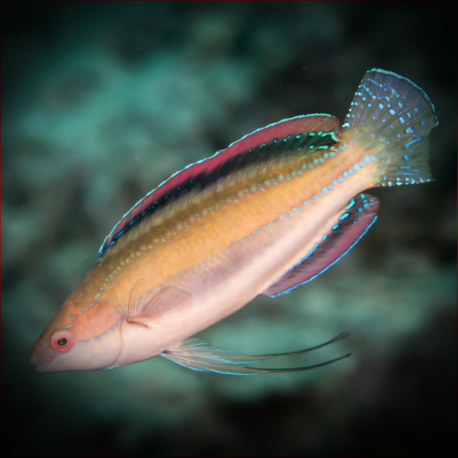More info
Datasheet
| Minimum Tank Size | 400 litres / 105.67 US gallons |
| Maximum Size | 10.0cm / 3.94inches |
| Reef Compatible | Always reef safe |
| Temperament | Might be aggressive |
| Temperature | 22.2°C / 71.96°F - 25.6°C / 78.08°F |
| Specific Gravity | 1.020-1.025 |
| Carbonate Hardness | 8-12 |
| pH | 8.1-8.4 |
General Description
The Threadfin wrasse (Cirrhilabrus temminckii) is part of the colorful genus Cirrhilabrus and is well-suited to aquarium life. These fish are generally peaceful but can display aggression towards closely related species. They vary in boldness, with some immediately exploring the water column upon introduction while others prefer peace and quiet initially. Threadfin wrasses have a vibrant color variation, with males often being more colorful than females. Interestingly, males can change their gender from male to female and vice versa, showcasing unique behavior during courtship.
Aquarium Suitability
Threadfin wrasses are suitable for most aquariums but require a tank size of at least 400 liters, preferably more for larger groups. They do best as a pair (one male and one female) or with one male and multiple females. These fish can become aggressive, especially when not provided with enough space or when kept with very similar species. Adequate hiding places are essential in the aquarium setup to prevent aggression and allow for natural behaviors.
Demands, Care, and Hardiness
This species has an average level of hardiness and thrives in water conditions with a pH of 8.1-8.4, a specific gravity of 1.020-1.025, and a temperature range of 22.2-25.6°C. Threadfin wrasses are docile but sensitive during transportation and acclimatization, requiring close attention to avoid stress and potential health issues. Regular feeding, multiple times a day, is crucial, with a varied diet that includes small crustaceans and zooplankton to ensure optimal health and colorful appearance.
Reef Suitability
Threadfin wrasses are always reef-safe and make excellent additions to reef aquariums due to their peaceful nature and foraging habits that help control unwanted invertebrates. Their reef compatibility stems from their varied diet, which ranges from zooplankton to larger crustaceans, making them beneficial members of a reef ecosystem.
Aquarium Setup
When setting up an aquarium for Threadfin wrasses, ample space for swimming and hiding places such as live rocks are essential. A secure lid is necessary to prevent the fish from jumping out, as they are known to be capable of escaping open aquariums. The tank must also have a secure overflow to avoid injuries when the fish swim upwards in response to perceived threats.
Behaviour
Threadfin wrasses exhibit shy and docile behavior, making them vulnerable to more aggressive tankmates. Males can display rough behavior towards each other, but harmony is usually maintained in a group with one male and multiple females. Incorporating these fish simultaneously or introducing females before males can help establish a peaceful dynamic within the group.
Feeding and Diet
To ensure optimal health and color vibrancy, Threadfin wrasses require a varied diet consisting of small crustaceans like krill and artemia, as well as zooplankton such as Cyclops and pods. Frequent feeding, multiple times a day, is necessary, especially during the initial acclimatization period and for larger individuals. Monitoring their feeding behavior is crucial to detect any signs of injury or stress.
Dimorphism and Captive Reproduction
Threadfin wrasses exhibit significant dimorphism, with males displaying brighter and more varied colors compared to females. Additionally, males can lose coloration in the absence of females, highlighting the importance of group dynamics for maintaining their vibrant appearance. These fish have the fascinating ability to change gender from male to female and vice versa, adding another layer of intrigue to their captive behavior and breeding potential.
Habitat and Distribution
In the wild, Threadfin wrasses are found in the Western Pacific, ranging from Sagami Bay, Japan to the Philippines and northern Australia, including Western Australia. They inhabit coral reef environments where they contribute to the ecosystem by preying on various invertebrates. Their distribution underscores their affinity for tropical and subtropical regions with rich coral reef habitats, where they play a vital role in maintaining ecological balance.

